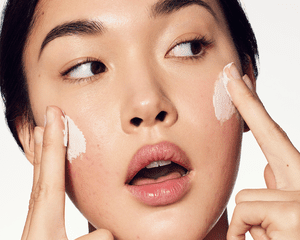:max_bytes(150000):strip_icc()/yellowpilltablets-f052a76d267c44f59992e5ead05c6c74.png)
Stocksy
If you feel like you've tried every ingredient to treat your inflammatory acne—and we mean everything, from hydrogen peroxide and salicylic acid to tretinoin and benzoyl peroxide—you've probably started looking into alternative treatments. If you find yourself in this situation, a visit with a dermatologist to address the underlying cause and develop a treatment plan is a must. And while it may not be the first line of action you think of when fighting against breakouts, there are certain cases when snagging a prescription antibiotic—like cephalexin— could be your best bet.
Cephalexin is better known for treating infections in the body. However, studies show that the med is worth taking to treat acne, too, as it contains anti-inflammatory properties and has the power to lower levels of acne-causing bacteria. Below, board-certified dermatologists Nikhil Dhingra, MD, Jeanette Black, MD, and Rebecca Baxt, MD, as well as a board-certified internal medicine specialist Ehsan Ali, MD, explain exactly what you need to know about taking cephalexin for acne purposes.
Scroll on to read up on the benefits, potential side effects, and ultimate guide to taking cephalexin for acne.
Meet the Expert
- Nikhil Dhingra, MD, is a board-certified dermatologist at Spring Street Dermatology in NYC.
- Jeanette Black, MD, of Skin Care and Laser Physicians of Beverly Hills, is a board-certified dermatologist.
- Rebecca Baxt, MD, is a board-certified dermatologist at BAXT CosMedical.
- Ehsan Ali, MD, is a board-certified internal medicine specialist and founder of Beverly Hills Concierge Doctor and Urgent Care.
Cephalexin
Type of ingredient: Antibiotic
Main benefits: Typically used to treat various bacterial infections, including bacterial skin infections and infected post-operative wounds.
Who should use it: According to Dhingra, cephalexin is occasionally utilized for acne flares for patients unable to tolerate minocycline or doxycycline (the common antibiotics for moderate-to-severe inflammatory acne). Cephalexin also might be a good option for women planning to become pregnant or currently pregnant but experiencing moderate-to-severe acne flares and can't use traditional acne treatments.
Works well with: Since very few oral medications are ideal as a monotherapy, Dhingra stresses the importance of continuing a topical regimen prescribed by your dermatologist.
Don't use with: Ali says when taking cephalexin, alcohol should be avoided; otherwise, there are no restrictions.
What Is Cephalexin?
Cephalexin (also known as Keflex) is an oral antibiotic typically used to treat a variety of bacterial infections, including bacterial skin infections. It's a first-generation cephalosporin that works to inhibit cell wall synthesis in certain bacteria, according to Black. If cephalexin sounds familiar, that's because it's a commonly used antibiotic for various infections, such as skin infections, sore throat, and UTIs, according to Ali. "Cephalexin isn’t by any means a novel antibacterial agent," Dhingra explains. "It has been around for quite a while and is used by dermatologists for other common skin infections and concomitantly with skin surgeries to prevent common infections."
More studies need to be conducted to discern the efficacy of cephalexin for treating acne, but Dhingra points to a 2008 analysis that looked at close to 100 patients treated with cephalexin. Eighty-four percent had tried and failed a different oral medication prior to a cephalexin trial, and the results showed nearly 75 percent of patients had improvement, with just over half experiencing significant improvement. However, Dhingra highlights that it wasn’t a formal study done comparing cephalexin to a placebo, which is the gold standard of scientific analysis. "Beyond that, the caveat that stands out most to me is that the average duration of treatment with cephalexin was 8.8 months, which is a lengthy duration to be on any type of antibiotic when safer long-term solutions exist, such as isotretinoin," notes Dhingra.
Skin Benefits
Antibiotics are one of the main categories of internal acne treatments because they can eliminate acne-causing bacteria and have an anti-inflammatory property, which helps prevent and treat acne. However, the oral antibiotics used for this purpose are typically minocycline and doxycycline. According to Dhingra, cephalexin isn’t actually able to penetrate the oil glands like the more traditional antibiotic choices can. So then the question becomes: in what instances would someone use cephalexin over all the other acne treatments? A few to note below:
- Those unable to tolerate other antibiotics: "The data is scarce, so it’s hard to offer a broad recommendation, but for a patient for whom doxycycline isn’t cutting it, and patients are maybe hesitant about other highly effective tried-and-true acne treatment—like spironolactone and isotretinoin—cephalexin may be a reasonable thing to bring up with your dermatologist," Dhingra explains. It should also be noted that cephalexin should only be used for inflammatory acne types (think red angry bumps, cysts, and pustules).
- Pregnant women: Since some traditional acne treatments are not safe during pregnancy, Dhingra says cephalexin might be a good option for women planning a pregnancy or who are currently pregnant and experiencing moderate-to-severe acne flares. It's important to note that this approach should be considered in conjunction with a board-certified dermatologist and obstetrician.
- Treats infections: According to Black, cephalexin is commonly prescribed for skin infections and infected post-operative wounds. "Given the growing risks of antibiotic resistance, prescribing cephalexin is typically reserved for active infections," Black explains. "Wound cultures can be taken to confirm a bacterial infection and test its sensitivity to antibiotics."
Potential Side Effects
According to Black, the antibiotic is usually well-tolerated, but it should be avoided in patients with allergies to cephalosporins. Baxt adds that there can be cross-reactivity to cephalosporins and sometimes penicillin, so anyone allergic to those should reconsider using cephalexin as a treatment.
Adds Ali, the risks or side effects of using an antibiotic, such as cephalexin, include allergic reactions, rash, nausea, and diarrhea. But perhaps the most concerning side effect of using an antibiotic to treat acne is antibiotic resistance and, therefore, definitely a reason to approach it with some caution. "Propionobacterium acnes, the bacterium responsible for acne flares, has exhibited a large rise in antibiotic resistance over the past few decades with use of antibiotics, in general," Dhingra explains. The other concern is that prolonged cephalexin courses can introduce the risk of resistance for other bugs like Staph bacteria, making treatment of other conditions with cephalexin more difficult, he notes.
To sum it up, before taking cephalexin, make sure you are not allergic to cephalosporins, be aware of the potential side effects, and notify your doctor of any unusual reactions.
How to Use It
Cephalexin should be taken as advised by your doctor, but Baxt says it would likely be prescribed twice daily for two to four weeks for acne. Black adds, "Long-term antibiotic use can be avoided by using other, often more effective treatment modalities."
The Final Takeaway
"For someone who has struggled long-term with acne, despite the best attempts at treatment with the standard fare of treatment options like doxycycline or minocycline, cephalexin might be a good option to try if you have inflammatory acne," Dhingra says. "This should be done in conjunction with a board-certified dermatologist comfortable with the gamut of acne treatments available." If the decision is made between you and your doctor to go down this route, it’s very important to continue a topical regimen prescribed by your dermatologist, as very few oral medications are as ideal as a monotherapy.




